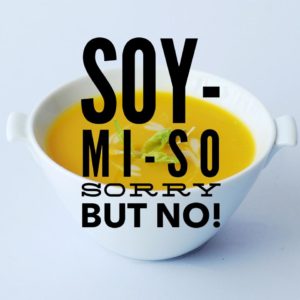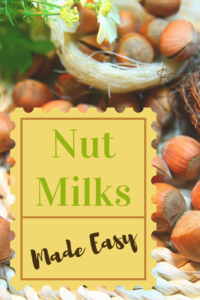Mi-so sorry, but soy is an unhealthy food!
Soy, soybeans and soy products have been used, and touted as a healthy product, for years. It is found in so many products that we can hardly read a label without seeing it pop up. Soy propaganda tells us that soy protects against breast cancer and osteoporosis so, like the Asian populations we should eat more tofu and other soy products. Not, really…
Soybeans are the second largest US crop after corn. 90% of the US soybean crops are genetically modified— This means that most soybeans come from a “frankenseed” that was designed in a lab to withstand the herbicides sprayed on it. “Round up” by Monsanto, the extremely toxic weed killer that keeps your lawn looking beautiful all summer long, is the primary one. In fact, the Monsanto company has it’s own soybean that it refers to as “Round-Up Ready”. This means the seed was designed specifically to endure their own pesticide product. Residue from glyphosate, the main chemical in Round Up, has been reported to be found at high levels on soybean plants.
Now you might be thinking “ well I don’t eat soybeans so I’m all good” well don’t forget the fact that soy is used as a filler in many products you probably eat on a daily basis.
Food manufacturers realized the need for creating cheap vegetable oils to keep their costs down. It was realized that soybeans could be turned into an oil. According to the US Soy Board, soy accounts for 61 percent of American’s vegetable oil consumption. When you consider what you just read about the large percentage of genetically modified soybeans that are also sprayed heavily with pesticides, this is a problem. The other problem is that all of the solids that were left after the soybean oil was created needed to be discarded– which can be an expensive endeavor.
But! Someone, somewhere (someone that was more concerned about money than your health) had the bright idea about how to get rid of this waste product: “Let’s use it as a filler” they said…”It’ll be much cheaper than disposing of it” they said….This filler comes in the form of isolated soy protein that can be found in all kinds of food products that people eat day in and day out— meat substitutes, crackers, soy burgers, ice cream, milk shakes, and fake cheese.
Soy lecithin is an additive found in many foods. It is extracted in the “degumming” process of making soybean oil. It is used primarily as an emulsifier, and you can find it in everything from salad dressing to tea bags. After reading and reviewing many articles it seems that soy lecithin is found in such small quantities in foods that it’s effects could be negligible unless one is allergic or particularly sensitive to soy. One of the best ways to avoid soy isolate and soy lecithin is to eat a whole foods diet.
Aside from the harmful effects of the pesticides that are sprayed on these GMO (genetically modified) soybeans, here are some of the other effects they can have on the body
- Soy contains phytoestrogens
Phytoestrogens are plant based estrogens called xenoestrogens that mimic estrogen in the body. High levels of estrogen (termed estrogen dominance) in the body are the leading cause of breast cancer, endometriosis, uterine fibroids, infertility and low libido. The studies funded by the soy industry will tell us otherwise but , well, they are funded by the soy industry so….
Here are the health ramifications and the symptoms associated with estrogen dominance (get ready, the list is long):
- Acceleration of the aging process
- Allergies, including asthma, hives, rashes, sinus congestion
- Autoimmune disorders such as lupus erythematosis, thyroiditis,and Sjoegren’s
- Breast cancer
- Breast tenderness
- Cervical dysplasia
- Cold hands and feet as a symptom of thyroid dysfunction
- Copper excess
- Decreased sex drive
- Depression with anxiety or agitation
- Dry eyes
- Early onset of menstruation
- Endometrial (uterine) cancer
- Fat gain, especially around the abdomen, hips and thighs
- Fatigue
- Fibrocystic breasts
- Foggy thinking
- Gallbladder disease
- Hair Loss
- Headaches
- Hypoglycemia
- Increased blood clotting (increasing risk of strokes)
- Infertility
- Irregular menstrual periods
- Irritability
- Insomnia
- Magnesium deficiency
- Memory loss
- Mood swings
- Osteoporosis
- Polycystic ovaries
- Premenopausal bone loss
- PMS
- Sluggish metabolism
- Thyroid dysfunction mimicking hypothyroidism
- Uterine cancer
- Uterine fibroids
- Water retention & bloating
- Zinc deficiency
Sadly, an infant taking the recommended amount of soy formula is taking in a hormone load equivalent of 4 birth control pills each day. It is not a wonder that puberty is starting as early with many young girls starting their periods as early as 6 and 7 years old!
Soy has quite a few other effects in the body:
- Soy contains goitrogens—Soy has some pretty disastrous effects on the thyroid gland. The thyroid gland plays a major role in heart rate, the nervous system, metabolism, muscle strength, body temperature, cholesterol and menstrual cycles. Goitrogenic foods suppress the thyroid. They prevent the thyroid from getting the amount of iodine necessary for proper function. When the thyroid is not functioning properly you often feel cold, have trouble regulating your moods and weight. You are more easily fatigued which makes it harder to get the gym and more likely for you to eat foods that don’t support good health and weight loss. A suppressed thyroid can affect you ability to concentrate. The thyroid is definitely and gland you want to take good care of!
- Soy blocks mineral absorption. The reason for this is that soy is high in phytates. Nuts and seeds are also high in phytates which is why it is so important to soak and pre-sprout them—soaking causes nut and seeds to start the germination process which makes the nut/seed a “live” food. They are much easier to digest and have lower phytates (mineral blocking enzymes) in this sprouted state. Soy is so high in these phytates that even soaking won’t do the trick. Soy must be fermented in order to be digestible. Miso, tempeh, natto or tamari are all forms of fermented soy. But, you also want to make sure your fermented soy products are organic because of the pesticides that are heavily sprayed on them as they grow
- Soy is not a complete protein—proteins are denatured in the processing temperatures required to make soy isolate and textured vegetable protein
- Soy increases the need for vitamin D
But what about the Asians? Way, way back in the day soy was farmed in China to improve soil fertility and to feed animals. The soybeans were not considered as a viable food product for humans until they began to be fermented, making them digestible. When the Asian populations health is used as an argument for the benefits of soy, this is because the Asians are eating FERMENTED soy, not, soy waste (Isolated soy protein) that has been used as a filler in everyday foods. It is also important to note that Asians eat only a few teaspoons of soy a day and it is fermented which makes it digestible. It is also not used as a filler for food that the typical American munches on all day long.
Ready to get rid of soy?
Are you a soy milk drinker? It’s time to make a switch! Nut milks are a MUCH healthier option and are so much easier to make than you probably think. I made you a super simple 1 page guide teaching you how to make very tasty nut milks at home!
Get the guide HERE

Click Here for the Guide
My challenge for you is to spend some time looking through your cupboards, refrigerator and freezer to seek out all of the products that contain isolated soy protein. I think you will be surprised to find out where it hides. To get you started on your way to reducing less soy, here are some great recipes for making your own nut milks. It is much easier than you probably think!



Trackbacks/Pingbacks